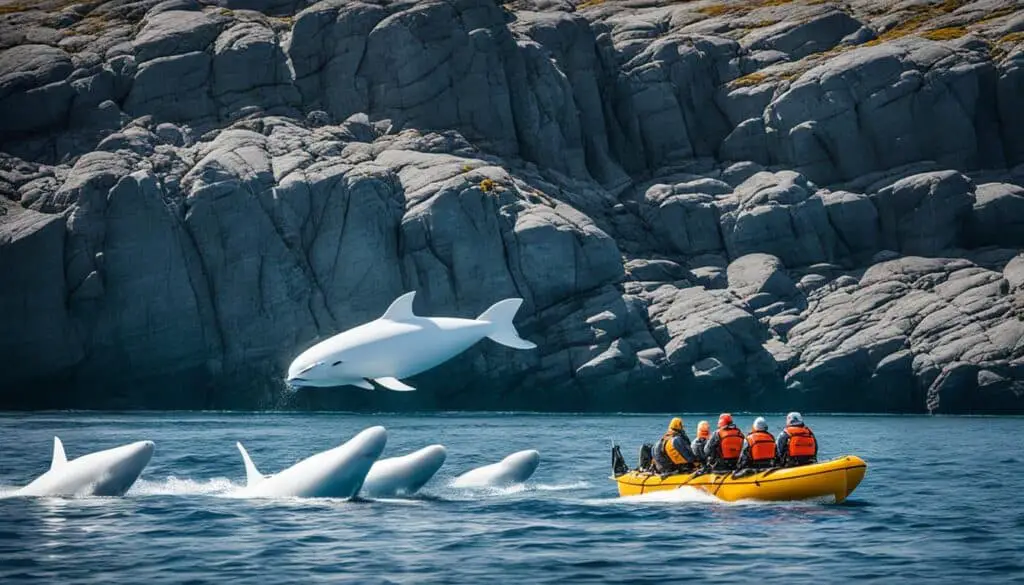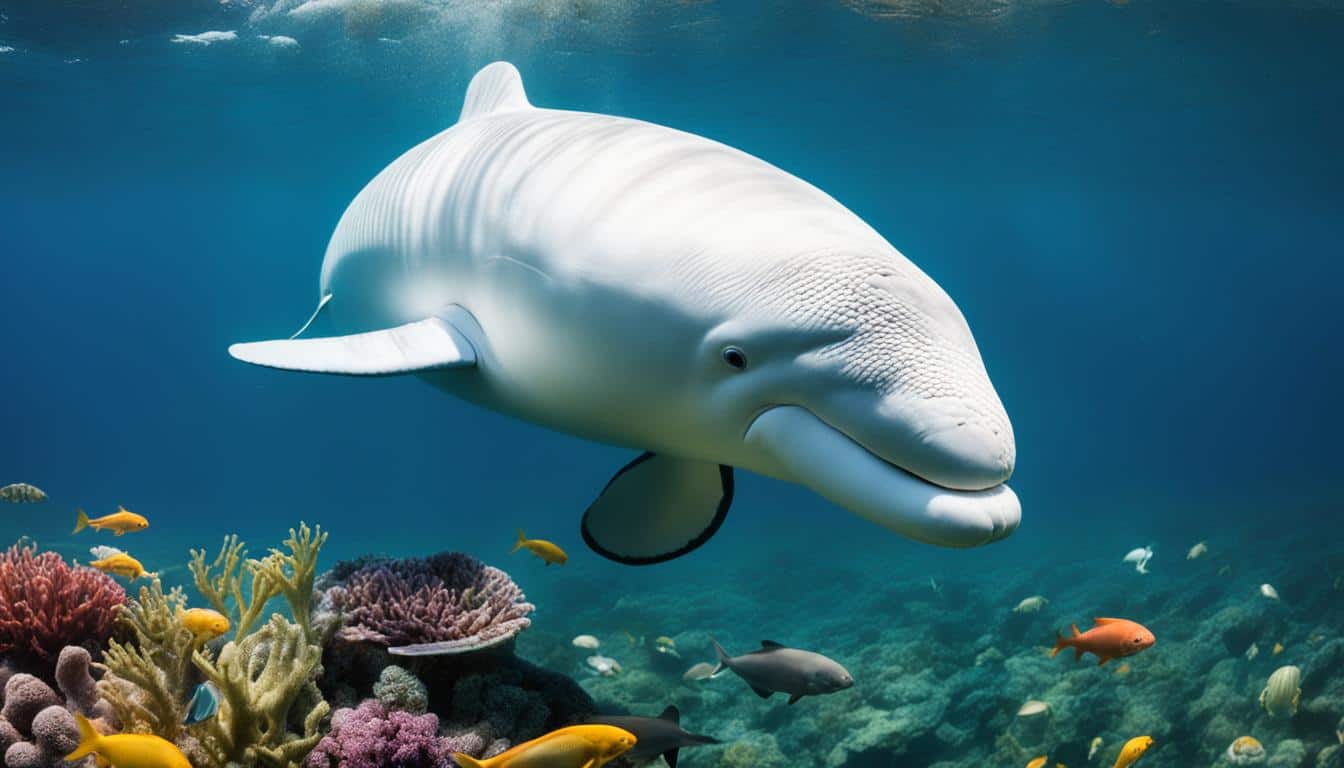Beluga whales, known as Delphinapterus leucas, are fascinating creatures. You might wonder, “What do they eat?” Their diet is quite varied, mainly made up of marine organisms from the ocean floor. They eat squid, crabs, and different types of fish like capelin and cod. This shows how well they adapt to life in the Arctic and sub-Arctic.
Learning about what beluga whales eat helps us understand their importance in the ocean. They need to eat about 40 to 60 pounds of food every day. Because they can swallow their prey whole, their eating habits are key to getting enough energy. We’ll look into their diet and the fish they hunt in the next sections.
Understanding the Beluga Whale Diet
Learning about the beluga whale diet helps us see their importance in the ocean. These marine mammals eat a wide variety of foods. Their eating habits let them live in different places. They mainly eat what’s available to them, changing their diet with the seasons and the number of their food sources.
Beluga whales hunt together, which makes them more successful. This teamwork also helps them form strong bonds with each other. How they work together to find and eat food is crucial to their survival.
Beluga whales can change their diet to fit their surroundings. Different groups of whales prefer different foods, based on what’s around them. This shows how important they are to their ecosystems and how well they can adapt.
What do beluga whales eat?
Beluga whales play a key role in the ocean’s ecosystem. They eat a variety of foods that show how adaptable they are. Their diet mainly includes fish, crustaceans, and mollusks. These foods are important for their health.
Major Food Sources of Beluga Whales
The main foods for beluga whales are:
- Salmon
- Capelin
- Herring
- Arctic cod
- Flounder
- Crabs
These foods are vital for their diet. Salmon and herring give them the energy they need, especially when they migrate.
Diverse Prey Base
Beluga whales eat a wide variety of foods. This lets them change their diet based on what’s available in their area. They hunt in both open water and on the ocean floor. This flexibility helps them survive in different environments.
Knowing what beluga whales eat is crucial for conservation and studying their role in the ocean.
Beluga Whale Food Habits
Beluga whales have fascinating food habits that show how they adapt in the wild. They hunt together, which helps them catch more food. This teamwork is key to their survival.
These whales live in shallow waters and use their flexible necks to reach food on the bottom. They eat a variety of things, including:
- Fish (like herring and cod)
- Crustaceans
- Sandworms
- Snails
Belugas change what they eat based on what’s available. This shows they are very adaptable. It helps them survive in different environments.
In zoos, belugas eat more than just sea creatures. They also like some plants. This shows their diet is more varied than we thought.
| Type of Prey | Habitat | Feeding Method |
|---|---|---|
| Fish | Open ocean and coastal areas | Swimming and chasing |
| Crustaceans | Benthic zones | Foraging on the seafloor |
| Sandworms | Shallow sediments | Digging and suction feeding |
| Snails | Nearshore environments | Direct consumption |
Types of Prey for Beluga Whales
Beluga whales eat a variety of prey. They mainly go for fish and crustaceans in the cold waters they live in.
Fish Varieties Consumed
Beluga whales eat many types of fish. Their diet often includes:
- Salmon
- Capelin
- Herring
These fish are key for belugas’ health and energy. They help them grow and stay active. The fish’s availability affects their hunting.
Crustaceans and Other Sea Creatures
Beluga whales also like to eat crustaceans. They hunt for:
- Shrimp
- Crabs
This shows how flexible beluga whales are in what they eat. Their diet shows their role in the ocean and how they adapt to different places.
Beluga Whale Feeding Behavior
Beluga whales have fascinating feeding habits that change with their environment and the food they find. They are very good at living in different places. They often hunt together to catch more food, which helps them survive.
Echolocation is key to how they find food. They use sounds to “see” their way around underwater. This lets them find and catch prey even in dark waters.
Beluga whales can change how they eat to fit their surroundings. This skill is important for them to live in changing ocean environments.
| Feeding Strategy | Description |
|---|---|
| Cooperative Hunting | Belugas hunt in groups, enhancing success rates when pursuing schools of fish. |
| Echolocation | Utilizes sound waves to locate and track prey in murky waters. |
| Adaptability | Changes feeding habits according to environmental conditions and prey availability. |
Beluga Whale Hunting Techniques
Beluga whales have developed smart hunting ways to catch their food. They use social behavior and physical skills to hunt in icy waters. This makes them great at getting food.
Group Hunting Strategies
Belugas hunt in groups, which is a key part of their strategy. They work together to herd fish into smaller groups. This makes it easier for them to catch the fish all at once.
They use sounds to talk to each other while hunting. This helps them plan their attacks together. Their teamwork makes them better at catching fish.
Foraging Methods on the Ocean Floor
Belugas also hunt on the ocean floor in unique ways. They use suction to get prey out from under the sand. This lets them eat animals that are hard to reach.
This shows how smart and flexible they are as hunters. Their hunting skills work well in different parts of the ocean.

Beluga Whale Nutrition and Energy Needs
Beluga whales live in cold oceans and need a diet rich in calories to stay healthy. They eat fatty fish and other sea creatures to get the energy they need. This diet is key for their survival and growth.
Belugas need to eat about 2.5% to 3% of their body weight every day. This is especially true during migrations when food can be scarce. Knowing about their energy needs shows how hard it is for them to find enough food.
Beluga whales rely on finding enough food to stay healthy. As you learn more about them, remember their diet affects their health and the ocean’s balance.
FAQ
What do beluga whales eat?
Beluga whales eat a mix of fish, crustaceans, and mollusks. They like to eat salmon, capelin, herring, Arctic cod, and flounder.
How much do beluga whales eat daily?
They eat about 2.5% to 3% of their body weight every day. That’s around 40-60 pounds of food.
Do beluga whales chew their food?
No, they don’t chew their food. They swallow it whole. They find their food in shallow waters.
What types of prey do beluga whales hunt?
They hunt many types of prey. This includes squid, crabs, sandworms, snails, and big schooling fish.
How do environmental changes affect the diet of beluga whales?
Changes in the environment and the amount of prey affect their diet. This shows how they adapt to new conditions.
What hunting techniques do beluga whales use?
They use different hunting methods. Sometimes, they hunt in groups to herd fish. Other times, they forage on the ocean floor.
How do beluga whales find their prey?
They use echolocation to find prey. This helps them hunt and navigate underwater.
What is the nutritional importance of the beluga whale diet?
Their diet is full of fatty fish and marine life. This gives them the calories they need to survive. It’s especially important during migration when food is scarce.







